It has taken us 46 episodes of seemingly non stop film camera discussion to finally devote an entire episode to the cameras that in the late 1990s and early 2000s, many photographers thought were a fad. That’s right folks, Camerosity has gone digital! Before anyone protests and demands their Camerosity Season Pass™ membership be refunded, enough time has passed since those early film-less cameras that the early digital cameras are now vintage themselves.
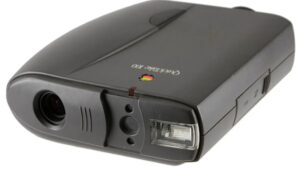 In episode 46 of the Camerosity Podcast, the guys and I go all digital. With us are callers Andrew Smith, Atabak Taghizadeh, Brian Howard, Greg McCreash, Mark Faulkner, Michael Gossett, Phil Clark, and Stephen Grasso.
In episode 46 of the Camerosity Podcast, the guys and I go all digital. With us are callers Andrew Smith, Atabak Taghizadeh, Brian Howard, Greg McCreash, Mark Faulkner, Michael Gossett, Phil Clark, and Stephen Grasso.
Anthony and Brian start things off with one of the earliest true digital cameras, the Apple QuickTake. This 0.3 megapixel monster was first released in 1994 and came in two distinct designs, one created by Kodak and the other by Fuji. Moving onto the Sony Mavica and it’s 3.5″ floppy disc storage, the rest of the gang has some familiarity of these cameras, and Anthony reminisces about his large collection of floppies.
We continue to traverse the late 90s and early 2000s, going around the room recalling our first digital cameras that really made us realize that cameras which write in 1s and 0s were here to stay. Mike discusses the differences between CCD and CMOS sensors, we dabble into digital IR photography and a couple Sony models which make disabling the visible light filter extremely simple. Mark prefers a more difficult way though, by opening up his Panasonic Lumixes and permanently removing the filter.
We cover digital mirrorless, and which mounts we all love adapting film lenses to, why some people didn’t like EVFs compared to optical viewfinders, Mike heaps praise on the Nikon Z5, and we dabble into some of the more strange digital camera designs like the Pixii and Lytro.
This was a loaded episode with a ton of information, so whether or not you’re interested in older digital cameras, or are interested to know what a (Zoom) room full of a dozen collectors shoot when we don’t feel like dealing with analog emulsion, you definitely do not want to miss this episode!
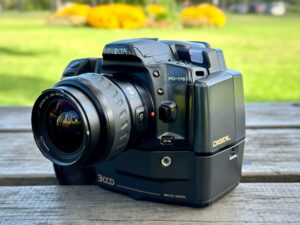 As always, the topics we discuss on the Camerosity Podcast are influenced by you! We would love to hear from more listeners, especially those who are new to shooting film or collecting cameras. Please don’t feel like you have to be an expert on a specific type of camera, or have the level of knowledge on par with other people on the show. We LOVE people who are new to shooting and are interested in having an episode dedicated to people new to the hobby, so please don’t consider your knowledge level to be a prerequisite for joining!
As always, the topics we discuss on the Camerosity Podcast are influenced by you! We would love to hear from more listeners, especially those who are new to shooting film or collecting cameras. Please don’t feel like you have to be an expert on a specific type of camera, or have the level of knowledge on par with other people on the show. We LOVE people who are new to shooting and are interested in having an episode dedicated to people new to the hobby, so please don’t consider your knowledge level to be a prerequisite for joining!
The guys and I rarely know where each episode is going to go until it happens, so if you’d like to join us on a future episode, be sure to look out for our show announcements on our Camerosity Podcast Facebook page, and right here on mikeeckman.com. We usually record every other Monday and announcements, along with the Zoom link are typically shared 2-3 days in advance.
For our next episode, we plan on going back to the analog realm, but now that the digital Pandora’s Box has been opened, will we forever be changed? The theme of our next episode is “cameras with a strap” meaning those which are permanently in shooting configuration, ready to fire off some exposures at a moment’s notice. What are your favorite cameras of all time, and which are the ones that someone will have to pry from your cold dead fingers, on the day you reach your expiration date! Be sure to look out for our next show announcement. Episode 47 will be recorded on Monday, April 17th. We hope to see you there!
This Week’s Episode
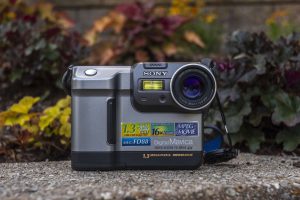 All hosts shoot digital, arguments on better medium are silly
All hosts shoot digital, arguments on better medium are silly- Anthony’s intro into digital, the Apple QuickTake / Brian’s Apple QuickTake 150, 100 and 200
- Anthony has lots of floppies / Mark and Theo both have Sony Mavica Cameras
- People don’t wipe card on old digicams, even birthing and wedding photos
- Mike shoots the Nikon E2Ns with a car lighter power cord
- Batteries are hard to find for pro grade equipment / Also hard to find for Leica D-Lux 2
- Greg has a Sony MVC-5000 with an AC to DC adapter
- Theo shoots a Minolta RD-175 / Press Compact Flash Cards from the middle to avoid bent pins
- Difficult to get images from early digital cameras onto computers now / Early DSLRs had no latitude
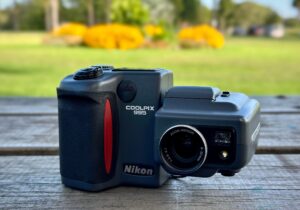 Innovation in form of Nikon Coolpix 995 / Early CCD vs CMOS sensors
Innovation in form of Nikon Coolpix 995 / Early CCD vs CMOS sensors- Sony DSC-505 was Anthony’s first significant digital
- Canon Powershot S2 was Mike’s first significant digital / Canon Powershot S45 and Nikon D300 were Theo’s first significant digitals
- Nikon D3 was Paul’s first significant digital
- APS-C is based on the named after the APS format / People love to adapt Pen-F lenses to Micro 4/3
- Micro 4/3 was a ground breaking innovation / Pentax Q has insane 5.5x crop factor
- Some mirrorless cameras are hard to find with lenses / DSLRs vs Mirrorless
- Fuji has a super loyal customer base / The Panasonic Lumix LX3 is a great pocket camera
- Adjusting to electronic viewfinders / Mike has a Nikon Z for vintage lenses and stacks a Sony to Nikon adapter
- Pixii Camera as a Leica competitor

- Sony has had a huge head start on the others / Sony manufactured sensors for most of the brands
- Infrared Red conversions on digital cameras / Using a magnet on a Sony CyberShot DSC-F828 to shoot IR / Military buys lots of IR cameras
- Pentax K1 and K10 / Sigma Merrill and Quattro / Stephen loves his Leica Q2 Monochrome
- Is the “film look” really a thing?
- Epson RD1 / Leica M8 was Leica’s first digital rangefinder camera
- Digital bridge cameras – Theo’s prediction of next big thing / The Digicam craze
- Mike gets excited because he can USB charge his Z5 / AI Integrated Photography might be the future
- Ricoh GRIII / Mike’s ultimate hybrid camera / Lytro Cameras
Show Notes
If you would like to offer feedback or contact us with questions or ideas for future episodes, please contact us in the Comments Section below, our Camerosity Facebook Group or Instagram page, or email us at [email protected].
The Official Camerosity Facebook Group – https://www.facebook.com/groups/camerositypodcast
Camerosity Instagram – https://www.instagram.com/camerosity_podcast/
Camerosity Twitter – https://twitter.com/CamerosityPod
Andrew Smith – https://www.youtube.com/channel/UClXrAlbnU3gvdRrJ5gAR4mw
Theo Panagopoulos – https://www.photothinking.com/
Paul Rybolt – https://www.ebay.com/usr/paulkris and https://www.etsy.com/shop/Camerasandpictures
Anthony Rue – https://www.instagram.com/kino_pravda/ and https://www.facebook.com/VoltaGNV/
Camerosity can also be heard on the following services:
YouTube – https://www.youtube.com/@camerositypodcast
Google – https://podcasts.google.com/feed/aHR0cHM6Ly9mZWVkLnBvZGJlYW4uY29tL2NhbWVyb3NpdHkvZmVlZC54bWw
Apple – https://podcasts.apple.com/us/podcast/camerosity/id1583252688
Amazon Music – https://music.amazon.com/podcasts/9d316c9e-5461-4fa5-9e04-24fd27fffc3f/camerosity
Podchaser – https://www.podchaser.com/podcasts/camerosity-1985806

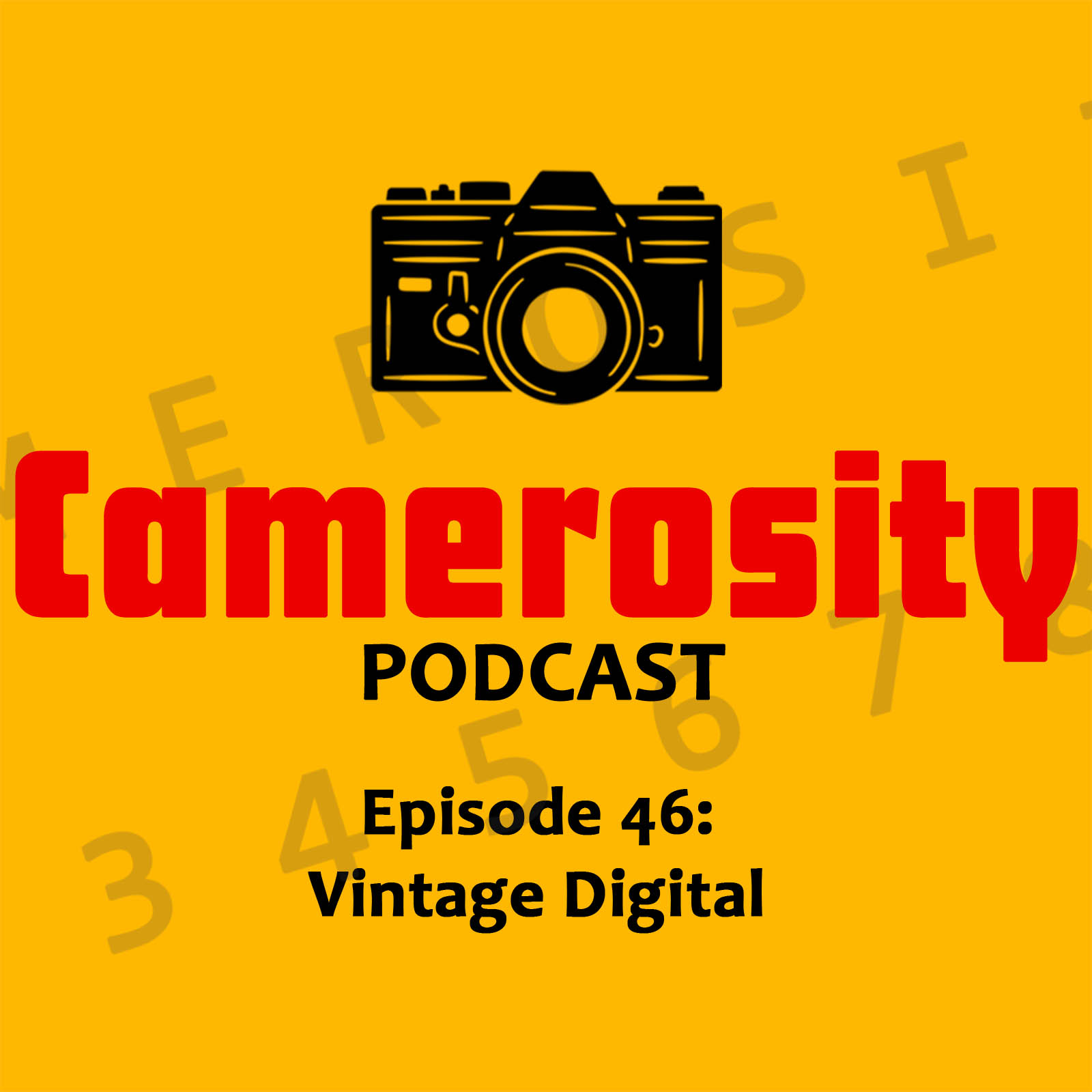
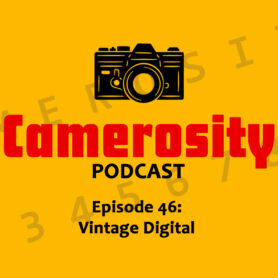

We used some Kodak DC40 cameras at work, back when they first came out. They were expensive. My recollection was that they cost us around $750 a copy. List price according to Popular Photography in November, 1995, was $995.
All Canon DSLRs were CMOS except the original 1D. They still had CCDs for their compact cameras for quite some time, though. Effectively, Canon DLSRs switched to CMOS in 2000.
Most imaging experts say that better colors from CCD is a myth. This is a complicated, and hotly contested topic. Personally, I think it’s possible that the colors are at least different because color filter arrays were changed for CMOS sensors, because CMOS was less sensitive than CCD.
Sony probably had the first bridge camera with a CMOS sensor in the DSC-R1 in 2004.
One interesting differentiator about CCD vs. CMOS is that there were only two full frame CCDs made (for regular still cameras): the Kodak 18MP used in the Leica M9, and the Phillips(?) 6MP used in the Contax N Digital.
Fuji Super CCD did not add a fourth color. Sony did that in the F828. Super CCD had different sized pixels to allow better DR (large for most of the image, small for highlights).
APS film was not just Kodak. It was almost everybody at the time: Nikon, Fujifilm, Minolta, Canon…
APS-H anyone? Kodak DCS 6MP cameras. Leica M8 and R4 digital back. EOS 1D series. In many of these applications it was because APS-H was the largest sensor you could fit behind a film camera’s shutter without modifying the body.
Paul, ask a Pentaxian to show you comparative shots from a year 2006 K10D (CCD sensor) and any current APS-C model, such as the popular K-3 (CMOS sensor). There is a significant difference in color saturation, with the CCD producing near-Kodachromesque images and the CMOS recording slightly muted tones. Some of us have kept our K10Ds in the collection for that very reason, even while we shoot daily with a full frame K-1 (CMOS).
I don’t doubt that the output is different. But there are many more differences than just swapping one silicon structure for another. The CFAs are different. The image processors are different. I don’t know much about the processing details, but people like Iliah Borg have posted some very long and sometimes strident positions against CCD doing anything that CMOS can’t do (currently, a lot of the better discussions on this topic are behind 403 errors at DPReview URLs). He wrote RawDigger, so he should know a decent amount about the low level data.
I’ve got plenty of CCD and CMOS cameras. I would think the CCD in my KonicaMinolta 7D or the one in my Nikon D200 should be similarly capable to the K10D. The one in my Fuji S5 Pro tested best, from what I could find, for color response at DXO (color response being, theoretically, the trade-off that manufacturers made in CFA design when switching from CCD to CMOS). There are even legends about the ones in my Kodak DCS460c and DCS760c using Kodachrome pigments for their CFAs. And then there are people who swear by the film emulations that Fuji applies in their current cameras… using CMOS sensors. And there are people who love the film like look of the original Canon 5D CMOS sensor.
Might be interesting to compare a Canon 1D to a 1D Mark II. They are pretty close in capabilities, but the 1D II has twice the CMOS pixels compared to the 1D CCD… also, no ambient WB sensor… However, back when the 1D II came out, people wanted CMOS sensors, and CCD had not yet garnered its mythic caché.
The Epson RD-1 used a Cosina/Voigtlander Bessa body. Nothing to do with Epson/Seiko being licensed. I don’t think the Bessa bodies read 6-bit codes, and the M mount itself must have been off patent since the late 1970s or so.
On an unrelated note, my daughter, who is 22, and is currently working on her masters in political science, sent me a video of her little Canon digicam (SD1100?), and each of three of her friends with their vintage-ish digicams, but she also likes shooting with a Yashica Electro 35.
The digital film cartridge stuff was (probably) a scam. The company that tried never had a working prototype. Distance back for the sensor is not the issue. The issue is that the frame behind the shutter is 24×36, and every sensor has glass over the sensor and contacts around the edge that make it difficult (so far, AFAIK, impossible) to have a full frame sensor that isn’t larger than the cutout. And the cover glass has to be thin enough put the sensor at the film plane without interfering with the shutter.
Funny to hear Mike with the same idea I had back in 2020 (hybrid film/digital with EVF): https://www.dpreview.com/forums/thread/4492038
You might consider a (written) blog post on the Canon Powershot series, from the first model forward.